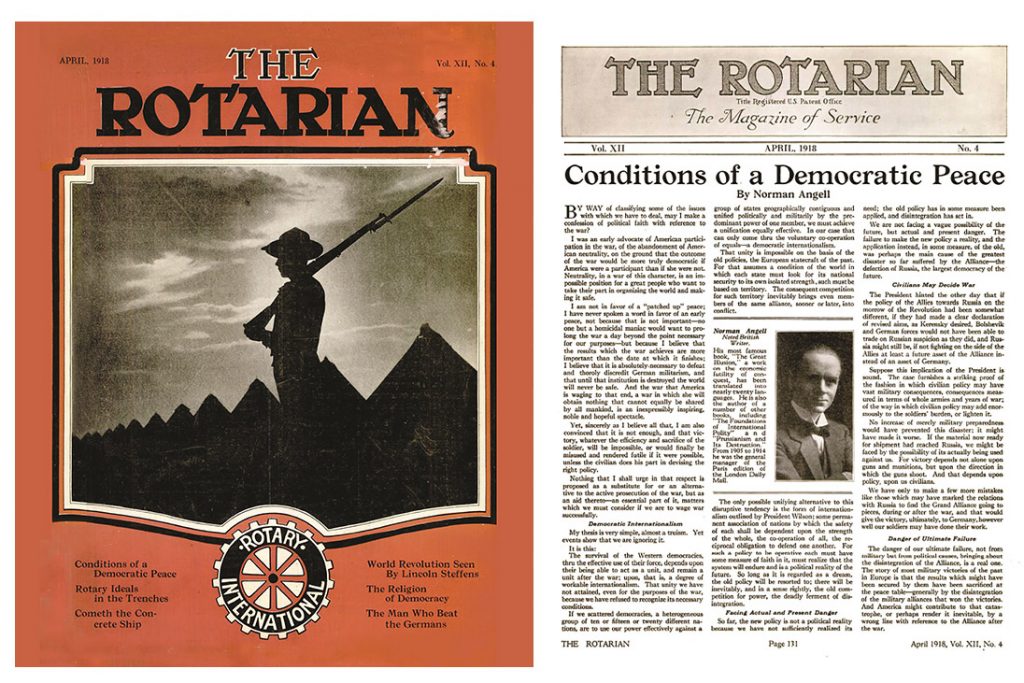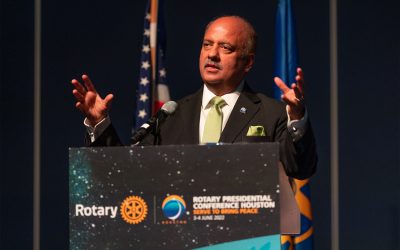In April 1918, months before the war’s end, Rotary was already envisioning what a post-war world would look like.
That month The Rotarian published an article by British writer Norman Angell called “Conditions of a Democratic Peace.”
In it, Angell, who would win the Nobel Peace Prize in 1933, championed American President Woodrow Wilson’s call for a League of Nations, a plan the president had been formulating since 1916.


A soldier stands vigilant on the cover of the April 1918 Rotarian, while inside, British writer Norman Angell looks forward to a peaceful postwar world.
Like Wilson, Angell knew he was fighting an uphill battle.
Nonetheless, he challenged those people who did not believe in the league because they thought it impractical.
“The truth is that it is not practical because we do not believe in it,” he argued.
“If we all believed in it and were determined to bring it about, that fact of itself would make it not only practical but inevitable.”
Then Rotary’s pre-war aspiration for “peace among the nations of the world” might finally be realised.
The greatest surrender in the history of humanity. It marked the ending of the battles of war and the beginning of the greater battles of peace.”
At 11am on November 11th, 47 miles north-east of Paris in the Forest of Compiègne, German delegates met with Allied commander Ferdinand Foch and signed the Armistice that ended the war. Rotary members rejoiced.
A more sanguine Philip R. Kellar, the managing editor of The Rotarian, characterised the Armistice as “The greatest surrender in the history of humanity. It marked the ending of the battles of war and the beginning of the greater battles of peace.”
But in mid-term elections held six days before the Armistice was signed, Republicans won control of both chambers of Congress.
Even a persuasive Democratic president would have a tough time beating those odds.
Within months, “the idealism of wartime was fading into the problems of the post-war period,” recounted Yale historian John M. Blum.
“Inflation, unemployment, and fears of Bolshevism” – this last was evident even in the pages of The Rotarian – “reduced public enthusiasm for a generous peace and for a genuine internationalism.”
A beautiful photo of the special WWI centenary commemorations in Tower Gardens. The light projection was commissioned by us from @TinfishCreative and the Tommy statues were donated by us and the Rotary Club of King's Lynn. You can see the projection every evening until 11/11 pic.twitter.com/U9dMYnGrHd
— WestNorfolkBC (@WestNorfolkBC) October 17, 2018
Congress never ratified the Treaty of Versailles, and though there would be a League of Nations, the United States would never become a member.
Even as Wilson’s dream collapsed, Rotary members imagined an international league of their own devising.
Harwood Hull articulated that concept in an address to his Rotary club in San Juan, Puerto Rico. (Hull’s speech appeared in the December 1919 Rotarian under the title “A Rotary League of Nations.”)
“The League of Nations and what it may accomplish to me seems no more of a dream, an idle vision, than Rotary itself,” Hull said.
“The same things that make Rotary possible will make a league of nations possible — personal contact, fellowship, friendship, understanding, tolerance, confidence and, above all, serving others in our work. …
“Some day, there will be a Rotary league of nations. It may not be the league we hear about now, but the league that is to be can succeed only to the extent that the principles of Rotary are accepted and applied in the dealing between nations as they are coming to be more and more demanded and in our dealing with each other.”
Don’t miss!
Historian David Fowler marks 100 years of the Armistice in December’s issue of the Rotary GBI magazine.










